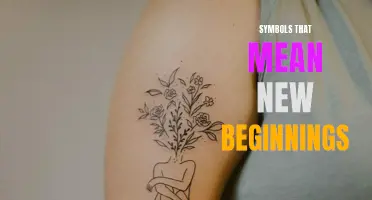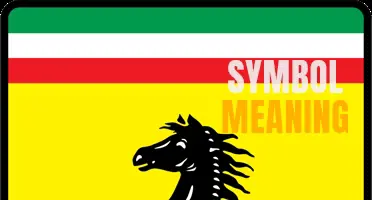
Kokopelli, the charismatic and enigmatic figure of Native American mythology, has long captivated and intrigued people with its fascinating symbolism. Depicted as a humpbacked flute player with a mischievous grin, Kokopelli has transcended time and cultural boundaries to become a powerful symbol of fertility, abundance, and joy. This revered figure is believed to bring rain, crops, and good fortune, and his presence has been associated with various legends, rituals, and even modern-day interpretations. In this article, we will delve into the rich kokopelli symbol meaning, exploring its origins, significance, and enduring appeal.
What You'll Learn
- What is the origin of the Kokopelli symbol and what does it represent in Native American culture?
- Are there different interpretations or meanings of the Kokopelli symbol across different tribes or regions?
- How has the meaning of the Kokopelli symbol changed or adapted over time?
- What are some common myths or legends associated with the Kokopelli symbol?
- How does the Kokopelli symbol relate to fertility and reproductive health in Native American belief systems?

What is the origin of the Kokopelli symbol and what does it represent in Native American culture?
The Kokopelli symbol is one of the most recognizable and widely known symbols in Native American culture. It is believed to have originated from the Ancestral Pueblo people, also known as the Anasazi, who lived in the Southwestern United States around 2,000 years ago. The symbol has since been adopted and incorporated into the culture of many Native American tribes in the region.
The Kokopelli symbol is often depicted as a humpbacked flute player, with a distinctive head and body shape. He is usually shown playing a flute or a similar musical instrument. The symbol is commonly associated with fertility, agriculture, and the arrival of spring. It is believed to bring good luck, abundance, and happiness to those who encounter it.
In Native American culture, the Kokopelli symbol is often associated with music, dancing, and storytelling. He is often seen as a trickster figure, bringing both joy and mischief wherever he goes. The flute he plays is believed to have the power to bring rain and fertility to the land, helping crops to grow and ensuring a bountiful harvest.
The Kokopelli symbol is also often associated with childbirth and is believed to bring fertility and good fortune to couples who are trying to conceive. In some tribes, it is believed that the hump on Kokopelli's back contains the seeds of unborn children, and that by listening to his flute playing, women can increase their chances of becoming pregnant.
The Kokopelli symbol has become popular outside of Native American culture as well, and is often used as a decorative motif in art and jewelry. Its positive associations with fertility, abundance, and happiness have made it a popular symbol for those seeking to bring these qualities into their lives.
While the exact origins of the Kokopelli symbol may be lost to history, its significance in Native American culture is still very much alive. It continues to be a cherished and revered symbol, representing the interconnectedness of nature, music, and fertility in the lives of Native American people.
Unlocking the Symbolic World of Pandas: Discovering the Meaning Behind their Endearing Image
You may want to see also

Are there different interpretations or meanings of the Kokopelli symbol across different tribes or regions?
The Kokopelli symbol is a popular figure in Native American culture, often associated with fertility, agriculture, and music. However, the meaning and interpretation of the Kokopelli symbol can vary across different tribes and regions. While there are some common themes and associations, the exact meaning of the symbol can differ depending on the cultural context.
The Kokopelli symbol is most commonly associated with the Southwest tribes such as the Hopi, Zuni, and Pueblo people. In these cultures, Kokopelli is often seen as a fertility deity, representing the cycle of life, reproduction, and abundance. It is believed that Kokopelli brings blessings to the people and the land, ensuring a successful harvest and a prosperous future. He is often depicted as a humpbacked flute player, with a distinctive headdress and a sack on his back, which is said to be filled with seeds.
In other tribes and regions, the meaning of the Kokopelli symbol may differ. For example, among the Navajo people, Kokopelli is seen as a trickster figure. He is believed to play pranks on people and possess magical powers. In this interpretation, Kokopelli is not necessarily associated with fertility or agriculture but is seen as a mischievous character who brings joy and laughter to the community.
Similarly, among the Native American tribes of the Great Plains, the Kokopelli symbol may have a different meaning altogether. The symbol is not as prevalent in these regions, and its associations may vary. Some tribes may view Kokopelli as a symbol of music and dance, highlighting the importance of these arts in their culture. Others may see him as a spiritual guide or a protector of the tribe.
It is important to note that the interpretations of the Kokopelli symbol are not fixed or universally agreed upon. Different individuals within the same tribe may have different interpretations of the symbol, and these interpretations can evolve over time. Additionally, outside influences and cultural exchanges may also shape the understanding and meaning of the Kokopelli symbol.
In recent years, the Kokopelli symbol has become popular in mainstream culture, often used as a decorative motif or a symbol of Southwestern aesthetics. However, it is crucial to approach the symbol with respect and an understanding of its cultural significance. By understanding the different interpretations and meanings of the Kokopelli symbol across different tribes and regions, we can appreciate its diversity and celebrate the richness of Native American cultures.
Decoding the Symbols: Understanding the Meaning Behind Night Owl Security Camera Symbols
You may want to see also

How has the meaning of the Kokopelli symbol changed or adapted over time?
The Kokopelli symbol is an iconic figure in Native American culture, particularly among the tribes of the Southwestern United States. Depicted as a humpbacked flute player, Kokopelli is believed to be a fertility deity, a bringer of rain and abundance, and a symbol of good luck and prosperity. While the exact origins and meaning of the Kokopelli symbol are still debated by scholars and historians, it is clear that the significance of this ancient figure has evolved and adapted over time.
Historically, Kokopelli was associated with agriculture and the fertility of the land. He was believed to have the power to ensure a bountiful harvest and to bring good fortune to those who honored him. The flute that he plays is said to have magical properties, capable of enticing crops to grow and attracting rain to the barren desert. Kokopelli was revered by Native American tribes as a vital spiritual figure, and his image often appeared in their pottery, rock art, and other forms of artwork.
As Western settlers and explorers began to encounter Native American cultures in the 19th century, the Kokopelli symbol caught their attention and sparked a curiosity among outsiders. The meaning and significance of the figure were gradually interpreted and adapted to fit the new narrative imposed by Western society. Kokopelli became a romanticized and commercialized symbol associated with the Southwest, appearing on everything from jewelry and clothing to tourist attractions and advertisements.
In the 20th century, Kokopelli experienced a resurgence in popularity, especially in the realms of New Age spirituality and popular culture. The symbol became associated with ideas of fertility, creativity, and self-expression, appealing to a broader audience beyond Native American communities. The figure of Kokopelli began to symbolize not only abundance and prosperity but also a free-spirited and joyful approach to life.
Today, the Kokopelli symbol continues to evolve and adapt in various contexts. Some Native American tribes still maintain the traditional spiritual significance of the figure, honoring Kokopelli as a sacred being. However, the symbol is also often used in a more commercial and mainstream manner, divorced from its original cultural context. It can be found on everything from home decor and tattoos to corporate logos and advertisements.
The meaning of the Kokopelli symbol has become multifaceted and subjective. It can represent different things to different people, depending on their cultural background, beliefs, and personal interpretation. For some, Kokopelli embodies a connection to nature, a celebration of life's abundance, and a symbol of hope and prosperity. For others, it may be seen as cultural appropriation or a superficial representation of Native American spirituality.
As with any cultural symbol, it is important to approach the Kokopelli figure with respect and understanding. Acknowledging its historical and cultural context while being open to its evolving meanings can help to foster a more inclusive and informed appreciation of this iconic symbol.
Unraveling the Enchanting World of Fairy Symbols and Their Meanings
You may want to see also

What are some common myths or legends associated with the Kokopelli symbol?
The Kokopelli symbol is an iconic image in Native American culture, particularly in the southwestern United States. It is often depicted as a humpbacked figure playing a flute, and is associated with fertility, music, and good fortune. However, there are also many myths and legends surrounding the Kokopelli symbol that have been passed down through generations. Here are some of the most common myths and legends associated with the Kokopelli symbol:
- Fertility: One of the most prevalent myths surrounding the Kokopelli symbol is its association with fertility. In Native American cultures, it is believed that Kokopelli has the power to bring fertility to the land and its people. It is often depicted with a large phallus, symbolizing its ability to bring forth new life.
- Music: Another common myth associated with the Kokopelli symbol is its connection to music. It is said that when Kokopelli plays his flute, the sound of his music can be heard across the land. This music is believed to bring joy and happiness to those who hear it, and is often associated with celebrations and gatherings.
- Good fortune: The Kokopelli symbol is also believed to bring good fortune and luck to those who encounter it. It is said that if you see a Kokopelli symbol, it means that good things are coming your way. This belief has led to the widespread use of the Kokopelli symbol in jewelry, artwork, and other forms of Native American crafts.
- Trickster: While Kokopelli is often seen as a benevolent figure, there are also myths that portray him as a trickster. According to some legends, Kokopelli has a mischievous side and enjoys playing pranks on people. This adds an element of unpredictability to the mythological character and adds to his appeal as a symbol of good fortune and luck.
- Traveler: In some Native American cultures, Kokopelli is seen as a wandering traveler who brings news from other tribes and communities. He is often depicted with a backpack or sack, symbolizing his role as a messenger and storyteller. This myth reflects the importance of communication and connection in Native American cultures.
In conclusion, the Kokopelli symbol is associated with several myths and legends in Native American culture. It is believed to bring fertility, music, and good fortune to those who encounter it. It is also seen as a trickster and a traveler in some myths, adding to its mystical and enigmatic nature. Whether seen as a deity, a spirit, or a symbol, Kokopelli continues to fascinate and inspire people around the world.
Exploring the Deeper Meaning and Symbolism of Diamonds
You may want to see also

How does the Kokopelli symbol relate to fertility and reproductive health in Native American belief systems?
The Kokopelli symbol holds significant importance in Native American belief systems, particularly regarding fertility and reproductive health. This iconic figure is often depicted as a humpbacked flute player, and its symbolism extends beyond music and entertainment. The imagery of Kokopelli has deep roots in Native American folklore and tradition, specifically related to the creation of life and the connection with nature.
Native American tribes from various regions, including the Hopi, Zuni, and Pueblo, attribute different meanings to the Kokopelli symbol. However, the general consensus revolves around the theme of fertility and the promotion of healthy reproductive functions. Many tribes believe that Kokopelli possesses extraordinary powers to bless couples with fertility, aiding in the conception of children. This belief has led to Kokopelli becoming a popular symbol associated with fertility rituals and prayers.
Kokopelli's association with fertility can be traced back to Native American creation stories. According to these legends, the flute-playing figure travels from village to village, bringing blessings of abundance and fertility to the land and its people. The music played by Kokopelli heralds the arrival of spring, symbolizing the renewal of life and the awakening of nature's reproductive cycles. In this way, Kokopelli represents the vital connection between human life and the natural world.
In addition to promoting fertility, the Kokopelli symbol is also believed to have a positive impact on women's reproductive health. It is often associated with healing rituals and ceremonies focused on enhancing women's well-being and addressing issues related to conception and childbirth. Women who seek to conceive or require assistance during pregnancy may turn to Kokopelli for support and guidance.
The significance of the Kokopelli symbol extends beyond the physical realm of reproduction. It also represents the emotional and spiritual aspects of creation and life. In Native American belief systems, balance and harmony are essential for healthy reproduction. Kokopelli embodies these principles, symbolizing the need to maintain a harmonious relationship with nature, the community, and oneself.
When it comes to reproductive health, the Kokopelli symbol serves as a reminder to live in harmony with one's body, mind, and environment. It encourages individuals to embrace their natural cycles and rhythms, fostering an overall sense of well-being. By honoring the teachings of Kokopelli, Native American communities strive to create a supportive environment that nurtures life and promotes ancestral traditions.
Today, the Kokopelli symbol remains a cherished motif in Native American art, jewelry, and home decor. Its popularity has spread beyond Native American culture, finding a place in contemporary fertility treatments and awareness campaigns. Many people have embraced the symbol as a source of inspiration and hope in their fertility journeys.
In conclusion, the Kokopelli symbol holds great significance in Native American belief systems concerning fertility and reproductive health. It represents the connection between humans and nature, promoting balance and harmony for healthy reproduction. Through music, rituals, and prayers, Kokopelli's presence blesses individuals with fertility while reminding them to live in harmony with themselves and the world around them.
Understanding the Symbols on Your Fitbit: A Guide to Decoding Their Meaning
You may want to see also
Frequently asked questions
The kokopelli symbol is a fertility deity often depicted as a humpbacked flute player. In Native American cultures, particularly in the Southwest United States, kokopelli is believed to bring good fortune, abundance, and fertility. The symbol is associated with rain, the earth, and crops, and is often seen as a sacred figure that brings blessings and harmony to the community.
While the kokopelli symbol is most commonly associated with Native American cultures, particularly the Pueblo and Hopi tribes, it has also become a popular symbol in contemporary Western culture. The kokopelli figure has been adopted by many as a symbol of joy, music, and good luck. It is often used in art, jewelry, and home decor, and has become a popular motif in New Age and spiritual communities.
The kokopelli symbol is often associated with male fertility, as the figure is typically depicted as a male flute player. However, in some Native American cultures, kokopelli is seen as a androgynous figure, representing both male and female fertility. The meaning and significance of the kokopelli symbol can vary slightly between different tribes and regions, but in general, it is seen as a positive and powerful symbol that brings good fortune and fertility to the community.







